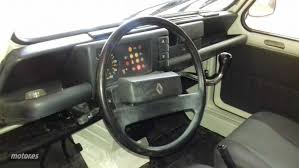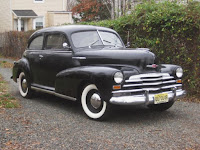I ASKED my car contact to find me a good, used
BMW 5 series. A new one would be well out of my financial reach as I didn't want to borrow, given the very high interest rates around 1990. And in no time at all he came up with a 1989 model, the
E34 as it was known in house. This was the first year of this model, replacing the
E28 which had that famous shark-like leaning-forward grille. And, of course, I fell in love at first sight. Or rather, first drive. The interior was every bit as well put together as the
Audi 80 but a little more glamorous, having lovely tan leather seats, a leather covered steering wheel in the proper 3 spoke shape, leather around the lovely gear lever controlling the 5 speed Getrag box and many other features that made this car a really upmarket vehicle. I rejoiced in the care taken to ensure the ergonomics were perfect - electric seats that moved up & down to provide enough head room, even with the sunroof open & the pedals & wheel being just the right distance away when adjusted to fit a 6 foot tall man.

In fact I liked this car so much that I kept it for 16 years! It took me to Nebraska & the Black Hills of South Dakota & although I would like to say "without trouble" I have to confess I can't. I didn't put big miles on it over the years, but even early on it needed brake rotors & a new clutch. I didn't mind however, as it was Just right, I felt. Well, almost. I did make a couple of "improvements" to put my mark upon it - a solid wood gear lever took my eye at the dealership one day, & my only lament was the absence of wood around it. So I took out the shiny, black plastic & spent several hours shaping a lovely strip of walnut to go in its place, as you see in the photo above.
Apart from that, the car was so well balanced that despite being rear-wheel drive, with decent Dunlop winter tires on I found that 5 inches of snow was traversable along my long, country driveway, before I even got the tractor out.
Because by then I was an apple farmer, with 15 acres & 250 lovely apple trees. Unfortunately, I was pathetic at that career, making insufficient money to properly support myself, so eventually I sold, in recognition also of my advancing years & the significant appreciation of the farm. But I was there for 7 years or so, & it was indeed an idyllic place...in the summer! Winters were another matter in this snowbelt region of central Ontario where spring often waited until May before appearing, somewhat shamefaced, & autumn seemed to be way too eager to push summer aside in early October.
Eventually those aspects & the cost of a new gas tank (the original had a rust hole in it) - $1000 ! - caused me to think about new horizons. The complex relationship with my ex-wife resulted in a move to "town" & with the sale came a new car. This time again, a really new one. Since I'd bought the farm a new-fangled service had become both normal & practical so it was online I was able to read about developments in automotive transport over the last 20 years. Where I lived was over 100 miles away from Toronto, so, from a practical point of view I visited dealers within 20 miles or so of my home. Being a dyed-in-the-wool imported car driver (confirmed over the years by occasional rentals of American cars) I was limited to
VW, Honda, Nissan, Hyundai &
Subaru from what I could see. The trend towards all wheel drive crossovers was in full swing & seemed sensible for someone living in a semi-rural environment. I drove all the mid-range models I could - except for the too expensive & too big
Toureg - including the quite luxurious
Vera Cruz, the
Pilot & also the
Tribeca & Nissan Murano.

It was fairly easy to filter out the
Pilot as I thought it clumsily soft & too much akin to driving a Buick. The
Vera Cruz did appeal, but was too big - I didn't need 3 rows of seats. When I got to the
Murano I hesitated. The size was just right & I particularly liked the way the pedals moved forth & back to accommodate long or short legs, but still maintaining a preset distance to the steering wheel.
But it was a bit dear & I worried about gravel roads chipping away at the wheel wells which didn't seem to have a plastic lip as protection.
Now V & I had had a
Subaru Forester some 15 years earlier, & I had fond memories of that boxy first edition
Forester so went across the road to the
Subaru dealer. Thinking again of the
Forester.But then I saw the Tribeca, with what I thought was a very attractive interior - it looked very modern & spaceship-like with a bright, swoopy aluminium (really plastic, but well done) fascia.
When I read the reviews, they were very positive about the
Tribeca, saying it had good handling (which it did) & a decent engine. So I bought one.
We took that car down to South Carolina & were really, very pleased with it. It was comfortable, roomy for all our stuff, had enough power - a 3 litre flat 6 cylinder - and was, I thought, quite an attractive vehicle. The front end apparently, according to the manufacturer, was intended to resemble an aircraft's wings & I agree, it does have that look. But a stupid journalist complained about the appearance, thought it looked pig-like, & from then on, every reviewer criticised the appearance, which very quickly had an effect upon sales. Within 2 years of the 1996 release the front end was reshaped into something very boring, & what had been a good shape, was now rubbish. So, when, 6 years later I decided to move on, that image was adversely reflected in the trade-in price.
 And happy we were in our new home. We'd left all the snow & bitter cold behind & were now living beside the Pacific Ocean. That's the way things would have stayed, except that we'd been persuaded to lease this blue car, instead of buying it outright. In the end, it worked out just fine, but after 3 years with the Infiniti FX37 it was time to turn it in.
And happy we were in our new home. We'd left all the snow & bitter cold behind & were now living beside the Pacific Ocean. That's the way things would have stayed, except that we'd been persuaded to lease this blue car, instead of buying it outright. In the end, it worked out just fine, but after 3 years with the Infiniti FX37 it was time to turn it in.



























